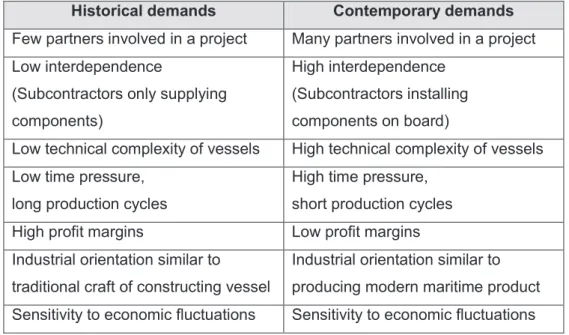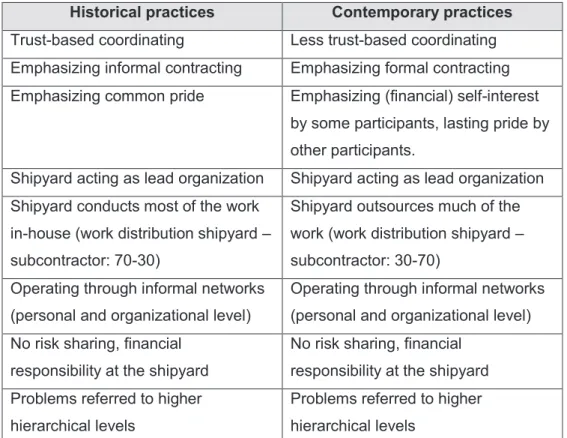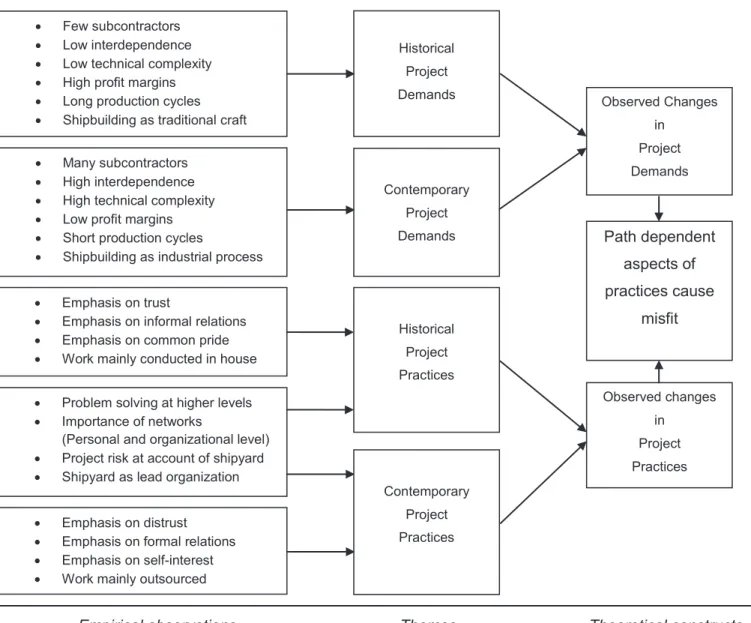How inter-organizational project practices and requirements developed in the Dutch shipbuilding industry between 1950 and 2010 and to what extent these developments help us understand the current mismatch between project practices and requirements. Our results show that a network of self-reinforcing mechanisms at least partly explains the current mismatch in the Dutch shipbuilding industry. Apart from the shipbuilding industry (Ahola, Laitinen, Kujala, & Wikström, 2008) they can be found in various industries such as film production (Bechky, 2006) and theater production (Goodman & Goodman, 1976).
Responding to this call, we adopt a historical perspective in our examination of IO project practices in Dutch shipbuilding. The main thrust of this paper is that the mismatch between contemporary IO project practices and requirements in the Dutch shipbuilding industry is partly caused by historical conditions. Currently, some of the practices of the IO project are inconsistent with the contemporary requirements of the IO project.
The aim of this article is to investigate how the perceived mismatch between IO project practices and requirements in contemporary Dutch shipbuilding projects is partly rooted in the past and thus the result of path dependencies and lock-ins. We answer the following research question: How did interorganizational project practices and requirements in the Dutch shipbuilding industry develop between 1950 and 2010 and to what extent do these developments help us to understand the current mismatch between project practices and requirements. In the theoretical part, contingency theory is used to theorize the notion of agreement between IO project practices and requirements.
The starting point of this paper is the practices and requirements of IO projects, which we searched for in advance.
Findings
The misfit was identified based on the problems experienced and the goals of the marine improvement program. At the beginning of the seventh century we were the largest shipbuilder in Europe, perhaps in the world. However, as described in a British research report, the position of the Dutch shipbuilding industry remained precarious:.
Due to these factors, compounded by decreasing profit margins and the sector's continued sensitivity to economic fluctuations, the current Dutch shipbuilding industry can be described as a versatile and dynamic environment. In the second half of the twentieth century, shipyards did most of the work themselves. The shipyards mostly carried out most of the project work themselves and the community took great pride in the work.
It could be, for example, that the project manager had an argument with the subcontractor's project manager because he lagged behind on delivery times or quality. They coordinate and monitor the activities of the subcontractors, communicate exclusively with the end customer and also bear the majority of the risk on the project. At the beginning of the second half of the twentieth century, IO project practice in Dutch shipbuilding was characterized by flexible contract application and by relationships primarily based on trust.
Another finding is the decay of the shared pride that once characterized the Dutch shipbuilding industry. Others, however, emphasize self-interest, either financial or otherwise, even if it is at the expense of the project. First, the complete financial responsibility on the shipyard's account, which remained the same over time, does not fit with the current project requirements of greater interdependence between project participants and lower profit margins in the Dutch shipbuilding industry.
These requirements require a comprehensive project-oriented attitude of all partners involved in order to achieve the goal of a stronger competitive position of the Dutch shipbuilding industry. When pricing a project, it must be taken into account that something can go wrong. The subcontractor is not used to this; yes, their small responsibility, but never as part of a larger process.” – Retired shipowner.
Shifting responsibility to subcontractors would require significant investment to master new, unfamiliar skills, both on behalf of the shipyards and subcontractors. To understand the mismatch between requirements and practices in Dutch shipbuilding projects, we supplemented the contingency theory with the path dependency perspective to avoid the static and ahistorical attitude of the earlier theory.
Implications and directions for future research
Since IO project practices, especially informal ones, are rarely written down, such an archival approach in our opinion should be combined with oral history. However, respondents did not give the impression of believing that everything was better in the old days, and in some cases concluded that current problems are no different from the problems of 60 years ago. Furthermore, many of the retired shipbuilders we interviewed are still active in industry associations, enabling them to reflect on historical and contemporary practices and requirements.
Given these various limitations, future research may benefit from developing more objective measures of self-reinforcing mechanisms and from applying a multimethod approach that combines the use of documents, archives, and statistical analysis. The nature and diffusion of interorganizational project ventures: Evidence from a large-scale field study in the Netherlands 2006-2009. Founding the Future: Path Dependence in the Evolution of Top Management Teams from Founding to IPO.
Change in the presence of fit: the rise, fall, and renaissance of Liz Claiborne. The missing link between the theory and empiricism of path dependence: conceptual clarification, testability issue and methodological implications. Scheepswerf acts as leading organization Scheepswerf acts as leading organization Scheepswerf carries out most of the work.
Low interdependence / Few partners involved in the project: “The most important thing is that at that time the yard wanted to do everything itself. They controlled everything themselves." (-retired shipbuilder). Positive) Economic sensitivity / Long production cycles: “And my boss said to me 'there's a stack of papers, good luck'. Many external partners involved: “Subcontractors became increasingly important because the entire operation of the ship depends on the performance and quality of the subparts.
Work through informal networks / Problems referred to higher hierarchical levels: "When the board of site X came over to talk to the board of site Y, they always looked past our department and said: You work together, we want to fight at the top. It's often the most effective way to get a result.” (-Retired shipbuilder) Emphasizing informal contracting: “The rivalry between the Dutch shipbuilders in those days was legendary. Emphasis on formal contracting / Emphasis on (financial) self-interest: "It's much easier if you can sort things out on the production floor, much, much easier.
And the contract structure and purchase terms are written in such a way that you as a subcontractor have no say in the overall picture. The shipyard subcontracts 70% of the entire ship, but these subcontractors have no influence on the construction process.


